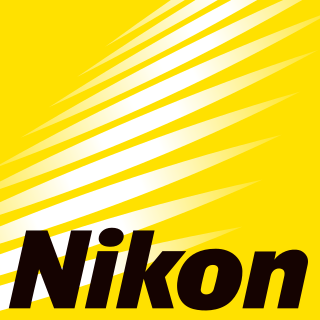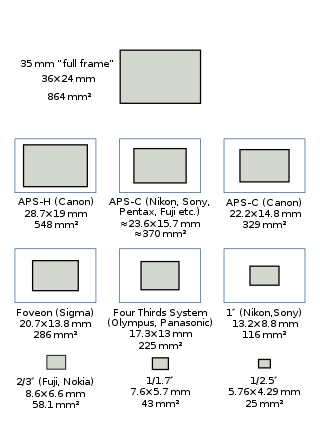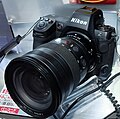
Nikon Corporation, also known just as Nikon, is a Japanese multinational corporation headquartered in Tokyo, Japan; it specializes in creating and marketing optics and imaging products. The companies held by Nikon form the Nikon Group.

A digital single-lens reflex camera is a digital camera that combines the optics and the mechanisms of a single-lens reflex camera with a solid-state image sensor and digitally records the images from the sensor.

A full-frame DSLR is a digital single-lens reflex camera (DSLR) with a 35 mm image sensor format. Historically, 35 mm was one of the standard film formats, alongside larger ones, such as medium format and large format. The full-frame DSLR is in contrast to full-frame mirrorless interchangeable-lens cameras, and DSLR and mirrorless cameras with smaller sensors, much smaller than a full 35 mm frame. Many digital cameras, both compact and SLR models, use a smaller-than-35 mm frame as it is easier and cheaper to manufacture imaging sensors at a smaller size. Historically, the earliest digital SLR models, such as the Nikon NASA F4 or Kodak DCS 100, also used a smaller sensor.

The Nikon D700 is a professional-grade full-frame digital single-lens reflex camera introduced by the Nikon Corporation in July 2008 and manufactured in Japan. It uses the same 12.1-megapixel "FX" CMOS image sensor as the Nikon D3, and is Nikon's second full-frame digital SLR camera.

The Micro Four Thirds system is a standard released by Olympus and Panasonic in 2008, for the design and development of mirrorless interchangeable lens digital cameras, camcorders and lenses. Camera bodies are available from Blackmagic, DJI, JVC, Kodak, Olympus, Panasonic, Sharp, and Xiaomi. MFT lenses are produced by Cosina Voigtländer, DJI, Kowa, Kodak, Mitakon, Olympus, Panasonic, Samyang, Sharp, Sigma, SLR Magic, Tamron, Tokina, TTArtisan, Veydra, Xiaomi, Laowa, Yongnuo, Zonlai, Lensbaby, Venus Optics and 7artisans amongst others.

A mirrorless camera is a camera that does not have a mirror. Though most cameras, including those used in smartphones, lack mirrors, the term mirrorless is primarily used to describe digital interchangeable lens cameras, in order to distinguish them from DSLRs, which have historically dominated interchangeable lens cameras. Lacking a mirror system allows the camera to be smaller, quieter, and lighter.

The Nikon D3100 is a 14.2-megapixel DX format DSLR Nikon F-mount camera announced by Nikon on August 19, 2010. It replaced the D3000 as Nikon's entry level DSLR. It introduced Nikon's new EXPEED 2 image processor and was the first Nikon DSLR featuring full high-definition video recording with full-time autofocus and H.264 compression, instead of Motion JPEG compression. It was also the first Nikon DSLR to provide high-definition video recording at more than one frame rate.

The Nikon 1 J1 is a Nikon 1 series high-speed mirrorless interchangeable-lens camera with 1" sensor size launched by Nikon on September 21, 2011. It is a new model that focuses on high-performance, portability and versatility. Nikon lists the estimated selling price of the Nikon 1 J1 One-Lens Kit in the United States at $649.95. Released on October 20, 2011, this kit comes with the 1 NIKKOR VR 10-30mm f/3.5-5.6 lens.

The Nikon Expeed image/video processors are media processors for Nikon's digital cameras. They perform a large number of tasks: Bayer filtering, demosaicing, image sensor corrections/dark-frame subtraction, image noise reduction, image sharpening, image scaling, gamma correction, image enhancement/Active D-Lighting, colorspace conversion, chroma subsampling, framerate conversion, lens distortion/chromatic aberration correction, image compression/JPEG encoding, video compression, display/video interface driving, digital image editing, face detection, audio processing/compression/encoding and computer data storage/data transmission.

The Sony α7, α7R, α7S and α7C are four closely related families of full-frame mirrorless interchangeable-lens cameras. The first two were announced in October 2013, the third in April 2014 and the fourth in September 2020. They are Sony's first full-frame mirrorless interchangeable lens cameras and share the E-mount with the company's smaller sensor NEX series.

CFexpress is a standard for removable media cards proposed by the CompactFlash Association (CFA). The standard uses the NVM Express protocol over an PCIe 3.0 interface with 1 to 4 lanes where 1 GB/s data can be provided per lane. There are multiple form factors that feature different PCIe lane counts. One of the goals is to unify the ecosystem of removable storage by being compatible with standards already widely adopted, such as PCIe and NVMe. There already is a wide range of controllers, software and devices that uses these standards, accelerating adoption.

The Nikon D7500 is a 20.9-megapixel digital single-lens reflex camera using an APS-C sensor. It was announced by Nikon Corporation on 12 April 2017, and started shipping on 2 June 2017. It is the successor to the Nikon D7200 as Nikon's DX format midrange DSLR.

Nikon Z-mount is an interchangeable lens mount developed by Nikon for its mirrorless digital cameras. In late 2018, Nikon released two cameras that use this mount, the full-frame Nikon Z 7 and Nikon Z 6. In late 2019 Nikon announced their first Z-mount camera with an APS-C sensor, the Nikon Z 50. In July 2020 the entry level full-frame Z 5 was introduced. In October 2020, Nikon announced the Nikon Z 6II and Nikon Z 7II, which succeed the Z 6 and Z 7, respectively. The APS-C lineup was expanded in July 2021, with the introduction of the retro styled Nikon Z fc, and in October 2021, Nikon unveiled the Nikon Z 9, which effectively succeeds the brand's flagship D6 DSLR. The APS-C lineup was further expanded with the Nikon Z 30, announced at the end of June 2022.

The Nikon Z 7 is a 45.7 megapixel full-frame mirrorless interchangeable-lens camera produced by Nikon. The camera was officially announced on August 23, 2018, for release in September 2018. It was the first camera to use Nikon's new Z-mount system; the second model, released in November 2018, was the 24.5 megapixel Nikon Z 6.

The Nikon Z 6 is a full-frame mirrorless interchangeable-lens camera produced by Nikon. The camera was officially announced on August 23, 2018, to be released in November. Nikon began shipping the Z 6 to retailers on November 16, 2018. This was the second camera to use Nikon's new Z-mount system after the release of the 45.75 megapixel Nikon Z 7 in September 2018.

The Canon EOS R is a 30.3 megapixel full-frame mirrorless interchangeable-lens camera launched by Canon in October 2018.

The Nikon D780 is a full-frame DSLR camera announced by Nikon on January 6, 2020. It was released for purchase on January 23, 2020. It is the successor to the Nikon D750.

The Nikon Z 6II is a high-end full-frame mirrorless interchangeable-lens camera (MILC) produced by Nikon and is the successor to the Nikon Z 6. The camera was officially announced on October 14, 2020 alongside the Nikon Z 7II, and became available for purchase on November 5.

The Nikon Z 7II is a high-end full-frame mirrorless interchangeable-lens camera (MILC) produced by Nikon, and is the successor to the Nikon Z 7. The camera was officially announced on October 14, 2020, alongside the Nikon Z 6II, and became available for purchase on November 5. It uses Nikon's Z-mount system.

The Nikon Z 9 is a full-frame mirrorless camera produced by Nikon. The camera was announced on October 28, 2021.




























